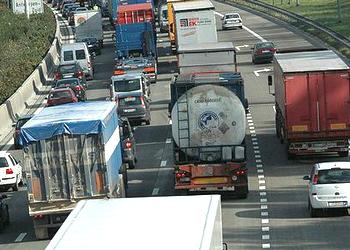
STRASBOURG, France, March 11, 2015 (ENS) – The European Parliament Tuesday gave its final approval to new EU rules for safer and more eco-friendly lorries, the long-haul tractor-trailors designed to transport cargo.
The Parliament approved Directive 2013/0195, put forward by the Commission, which increases the maximum authorized dimensions in national and international traffic and the maximum authorized weights in international traffic.

These rules were agreed informally by the Italian Council Presidency and Parliament negotiators last December.
The changes to the Weights and Dimensions Directive of 1996 approved by Parliament will allow manufacturers to use new designs for lorries, which may exceed current weight and length limits if they improve overall environmental and safety performance.
The new rules are designed to allow manufacturers to develop more aerodynamic lorries which will reduce fuel consumption by seven to 10 percent, cut emissions of greenhouse gases, and enhance road safety.
Violeta Bulc, EU Commissioner for Transport said, “Today’s final backing by the European Parliament is a significant achievement, which takes us one step closer to having better lorries on our roads. This will lead to fewer emissions and casualties on our roads and lower fuel costs for hauliers.”
“It will also allow the industry to produce new lorries and to remain competitive on the global market,” said Bulc.
“Today’s vote will pave the way for Member States to reach a final agreement, so that society can start to reap the benefits of these new rules,” she said.
The old rules are the reason why today’s lorries are brick-shaped, which is the least aerodynamic shape and the main reason for many traffic related casualties.
The new rules will help reduce greenhouse gas emissions and the consumption of petroleum products. This is considered crucial for road transport, which accounts for 82 percent of the energy consumption of the transport sector.
The steady rise in the price of fuel is continuously increasing Europe’s energy bill and prompted the Commission to identify solutions to reduce vehicle fuel consumption. The White Paper on Transport Policy published in 2011 set a goal of reducing greenhouse gas emissions by 60 percent by 2050 in comparison with 1990 levels.
The new rules also are expected to increase road safety. The current “brick shape” front of truck cabins can increase the severity of injury to road users in a collision. And it reduces the driver’s field of vision, which is particularly dangerous for cyclists and pedestrians at junctions.
A more rounded shape increases the field of vision and in the event of a low-speed collision, which typically occurs in an urban environment, and reduces the risk of serious injury.
“We will have safer trucks finally,” said the European Parliament’s rapporteur for transport Jörg Leichtfried of Austria, a member of the Group of the Progressive Alliance of Socialists and Democrats in the European Parliament.
Then there is the problem of overweighting that the new rules are meant to correct. Up to one third of controlled vehicles are overloaded, causing damage to roads and compromising safety. On-board weighing systems linked to the digital tachograph and weigh-in-motion stations on main roads will allow for more consistent checks from country to country.
The overweighting of lorries is estimated to cost €950 million per year to the taxpayer, said the Commission in outlining the new rules.
Better environmental performance is expected as a result of the revision. In the EU, transport relies on oil and oil products for about 96 percent of its energy needs. Improved vehicle aerodynamics will reduce the fuel consumption of long-distance road haulage by seven to 10 percent, making a significant economic and environmental contribution.
For hauliers, this will allow savings of approximately €5,000 per year in fuel costs for a typical long-distance tractor-trailer covering 100,000 kilometers, the Commission calculates.
The new rules allow for additional weight specifically to allow the use of heavier batteries required by hybrid and electric propulsion systems for lorries and coaches. Still, the loading capacity of lorries will not change.
The Commission expects the new rules will allow for greater innovation and industrial opportunities for vehicle manufacturers. The European heavy vehicle manufacturing sector is one of the largest corporate investors in research and development. New aerodynamic cabins and rear flaps will be an opportunity for manufacturers to develop new models, which will support job creation and economic growth in Europe, the Commission said..
The new rules are expected to promote intermodal transport. Red tape will be reduced, allowing 45-foot containers to be switched more easily between ship, road and rail.
Aerodynamic flaps are expected to come to market from 2018 and safer and more environmentally-friendly cabins from 2020. All other measures – propulsion, controls and intermodal – can be implemented from 2018.
The final step is the adoption by the Council of the European Union in the coming weeks. In parallel, the so-called EU vehicle type approval legislation needs to be updated, before new vehicles can be put on the market.
Copyright Environment News Service (ENS) 2015. All rights reserved.
